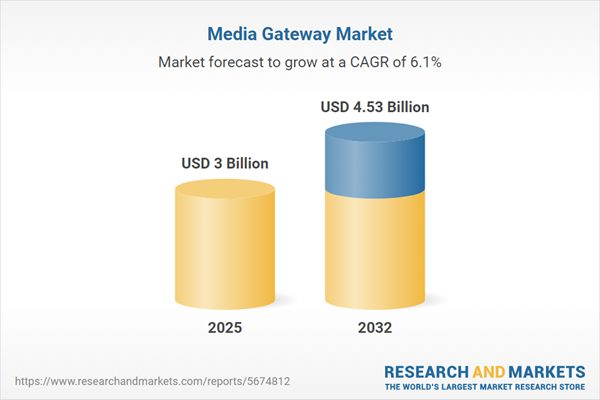Speak directly to the analyst to clarify any post sales queries you may have.
The media gateway market is navigating a complex era of transformation, where interoperability, security, and cloud-ready models position key players for enduring growth. This report equips senior decision-makers with the insight needed to stay ahead as the global communications landscape evolves.
Market Snapshot: Media Gateway Market Size & Growth Trajectory
The media gateway market expanded from USD 2.83 billion in 2024 to USD 3.00 billion in 2025 and is projected to reach USD 4.53 billion by 2032, reflecting a CAGR of 6.05%. This growth is underpinned by escalating demand for solutions that seamlessly connect legacy and IP-based networks, supporting unified communications and digital transformation across enterprises and service providers.
Scope & Segmentation of the Media Gateway Market
This comprehensive research delivers segmented insights on technology adoption, deployment strategies, end-user groups, and regional trends:
- Deployment Models: Cloud-based (private, public) and on-premises (physical gateway, virtual gateway) solutions deployed for tailored scalability and compliance.
- Component Types: Hardware (including processing hardware and voice boards) and software (encompassing protocol stacks and management platforms).
- Application Areas: Data (real time, non real time), video, and voice—including both PSTN and VoIP architectures—supporting unified collaboration.
- End Users: Enterprise (IT and telecom divisions) and service providers, each with distinct priorities around integration, security, and operational scale.
- Protocol Adoption: Session Initiation Protocol (SIP) and Time Division Multiplexing (TDM), aligning with the gradual migration from legacy to modern infrastructure.
- Regional Coverage:
- Americas (United States, Canada, Mexico, Brazil, Argentina, Chile, Colombia, Peru)
- Europe, Middle East & Africa (UK, Germany, France, Russia, Italy, Spain, Netherlands, Sweden, Poland, Switzerland, UAE, Saudi Arabia, Qatar, Turkey, Israel, South Africa, Nigeria, Egypt, Kenya)
- Asia-Pacific (China, India, Japan, Australia, South Korea, Indonesia, Thailand, Malaysia, Singapore, Taiwan)
- Key Vendors: Cisco Systems, Huawei Technologies, Ribbon Communications, AudioCodes, ADTRAN, Dialogic, ECI Telecom, Patton Electronics, RAD Data Communications, Sangoma Technologies.
Key Takeaways for Senior Decision-Makers
- Virtualization is reshaping the media gateway market, enabling software-based deployments on standard servers and fostering agile, scalable solutions for diverse requirements.
- Cloud-native architectures and microservices are driving innovations, allowing seamless updates and resilient service continuity across distributed voice, data, and video channels.
- Security remains a top concern, with organizations moving toward end-to-end encryption and proactive threat detection within both signaling and media transport layers.
- The adoption of hybrid gateway strategies balances regulatory compliance, performance needs, and cost efficiency as enterprises integrate legacy and cloud infrastructure in real time.
- Strategic vendor alliances with cloud providers and ecosystem partners enable deployment flexibility and unified management, supporting evolving enterprise workflows.
- Emerging regional dynamics, such as the widespread 5G rollout in Asia-Pacific and modernization in Latin America, are unlocking new opportunities for tailored deployments.
Tariff Impact on Media Gateway Supply Chains
Recent United States tariff policies have prompted manufacturers and service providers to reassess supply chain strategies. Many are shifting hardware sourcing, exploring regional supplier relationships, and moving toward software solutions to reduce tariff exposure. These developments contribute to reshaped procurement, longer-term contracts, and a focus on hybrid deployment models that enhance flexibility in the face of evolving regulatory environments.
Methodology & Data Sources
This analysis utilizes rigorous research combining primary interviews with industry stakeholders—including network architects and procurement leaders—and secondary review of vendor literature, technical papers, and regulatory filings. Data triangulation and peer validation ensure a robust foundation for every key finding and strategic recommendation.
Why This Report Matters
- Delivers actionable insights for capitalizing on emerging virtualization, security, and cloud-native trends within the media gateway environment.
- Equips strategy and procurement leaders with in-depth segmentation, competitive benchmarking, and regional market context to inform investment and deployment decisions.
- Supports effective risk mitigation by analyzing the operational impact of tariff changes and evolving supply chain configurations.
Conclusion
The media gateway market is progressing rapidly as organizations embrace cloud-native, virtualized, and secure solutions across global regions. This report provides the strategic guidance necessary to navigate ongoing transformation and sustain competitive advantage in a dynamic landscape.
Additional Product Information:
- Purchase of this report includes 1 year online access with quarterly updates.
- This report can be updated on request. Please contact our Customer Experience team using the Ask a Question widget on our website.
Table of Contents
3. Executive Summary
4. Market Overview
7. Cumulative Impact of Artificial Intelligence 2025
List of Figures
Samples

LOADING...
Companies Mentioned
The key companies profiled in this Media Gateway market report include:- Cisco Systems, Inc.
- Huawei Technologies Co., Ltd.
- Ribbon Communications Inc.
- AudioCodes Ltd.
- ADTRAN, Inc.
- Dialogic Corporation
- ECI Telecom Ltd.
- Patton Electronics Company
- RAD Data Communications Ltd.
- Sangoma Technologies Corporation
Table Information
| Report Attribute | Details |
|---|---|
| No. of Pages | 197 |
| Published | October 2025 |
| Forecast Period | 2025 - 2032 |
| Estimated Market Value ( USD | $ 3 Billion |
| Forecasted Market Value ( USD | $ 4.53 Billion |
| Compound Annual Growth Rate | 6.0% |
| Regions Covered | Global |
| No. of Companies Mentioned | 11 |









